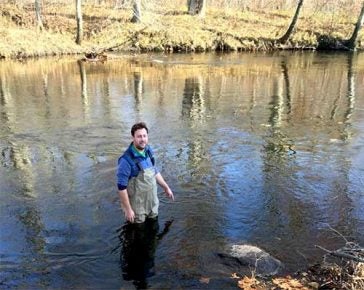
Traditional environmental water monitoring has long been based off the analysis of grab samples, directly collected in the field by scientists and analyzed in a lab. However, it can become costly and labor intensive to analyze a sample set large enough to fully understand the contamination of a lake, coastline, or drinking water resource. As an alternative, a novel passive sampler has been developed by the Lohmann lab for monitoring of PFAS that greatly reduces the time and resources needed for such analysis. These passive samplers are deployed for weeks or months during which time they gradually uptake PFAS. They require no field maintenance, no power supply, and are small enough to deploy in a variety of locations.
In fall 2019, STEEP trainee Matt Dunn deployed passive samplers at five sites across three rivers in Eastern Connecticut to further validate their efficacy. This work is being done in partnership with the state’s Department of Energy & Environmental Protection (DEEP). While analysis of the results is still underway, they will give both STEEP and CT DEEP a wealth of information regarding the extent of PFAS in the environment.
A major question Dunn hopes to address in his PhD is how a high flow rate environment, such as rivers or oceans, impacts the uptake of the passive sampler. The results from the environmental study in Connecticut will be compared to a laboratory-derived uptake model based on the flow speed and temperature of the water. Ideally, this will validate the model’s predictive ability, enabling the passive samplers to be easily deployed in a broad suite of field environments. CT DEEP will not only have a better understanding of potential PFAS contamination levels in their rivers but also will be able to better understand if these passive samplers can be a cost efficient and simple screening tool for statewide monitoring.

